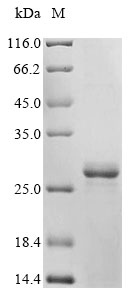Recombinant Saccharomyces cerevisiae Cytosine deaminase (FCY1) is expressed in E. coli and consists of the full-length protein from amino acids 1 to 158. This protein features both an N-terminal 10xHis-tag and a C-terminal Myc-tag, which help with purification and detection. The product shows a purity level greater than 85% as determined by SDS-PAGE, making it suitable for various research applications.
Cytosine deaminase is an enzyme that removes amino groups from cytosine to form uracil. This process appears to play a critical role in pyrimidine metabolism. The enzyme's activity draws particular interest from researchers studying metabolic pathways and enzyme mechanisms. As a key component in nucleotide metabolism, scientists frequently examine it in the context of genetic regulation and cellular processes.
Potential Applications
Note: The applications listed below are based on what we know about this protein's biological functions, published research, and experience from experts in the field. However, we haven't fully tested all of these applications ourselves yet. We'd recommend running some preliminary tests first to make sure they work for your specific research goals.
Based on the provided information, the recombinant Saccharomyces cerevisiae Cytosine deaminase (FCY1) is expressed in E. coli. As a yeast enzyme, FCY1 is a relatively small (158 aa) metabolic protein that may not require complex eukaryotic-specific post-translational modifications for proper folding. E. coli expression systems can often successfully produce functional forms of such enzymes. However, enzymatic activity is critically dependent on precise folding to form the active site. The presence of both an N-terminal 10xHis-tag and a C-terminal Myc-tag could potentially interfere with the protein's structure or oligomerization. Since activity is unverified, the protein's folding state and bioactivity remain uncertain. While the probability of correct folding may be reasonable, it cannot be assumed without functional validation (e.g., an enzyme activity assay).
1. Antibody Development and Immunoassay Optimization
This application is generally suitable. The recombinant FCY1 can serve as an effective immunogen for generating antibodies, as antibodies often recognize linear epitopes. The dual tags facilitate purification and detection in assays like Western blot or ELISA. The >85% purity is adequate for immunization. However, it should be noted that if the protein is misfolded, antibodies generated may not recognize the native, functionally folded FCY1 in yeast cells. Validation against native FCY1 is recommended.
2. Protein-Protein Interaction Studies
This application is highly dependent on correct folding. The dual tags are technically convenient for pull-down assays. However, if FCY1 is misfolded, its ability to interact with genuine biological partners involved in nucleotide metabolism will be compromised, potentially leading to the identification of non-physiological interactions. The full-length sequence is advantageous, but results are only reliable if the protein is natively folded. This application should be considered high-risk without prior activity confirmation.
3. Biochemical Characterization and Enzyme Kinetics Studies
This application is appropriate, but its purpose must be clarified. The protein can be used to develop and optimize assay protocols (e.g., spectrophotometric methods). However, if the goal is to study kinetics (e.g., determine Km, kcat), this is only valid if the protein is enzymatically active. Without activity confirmation, "enzyme kinetics studies" are not feasible. The initial experiments must focus on testing for activity before any kinetic parameters can be meaningfully measured. The protein can serve as a standard only if its activity is quantified first.
4. Comparative Proteomics and Cross-Species Analysis
This application is suitable for structural and expression-level comparisons. The defined tags allow for consistent detection and quantification when comparing expression across systems or with homologs. This use is less dependent on native activity, as it can focus on physical properties (size, stability, antibody reactivity). However, for "functional conservation studies," activity must be confirmed.
Final Recommendation & Action Plan
The critical first step is to determine if the recombinant FCY1 is correctly folded and active. A functional assay measuring the conversion of cytosine to uracil must be performed. If active, the protein can be used for all described applications, with kinetic studies becoming particularly valuable. If inactive, focus should shift to applications that do not require native conformation, such as antibody development (for linear epitopes) and comparative proteomics. For protein-protein interaction studies, activity is a prerequisite. The biochemical characterization studies should be initiated immediately to assess folding (e.g., via size-exclusion chromatography, circular dichroism) and to test for basic enzymatic function, which will guide all subsequent use cases.






